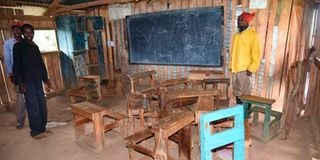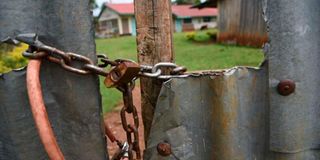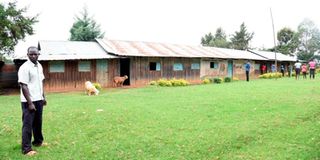Exit Nyakemincha, enter Chingondi: Kenya’s new ‘worst-performing’ school

Some parents inside one of the classrooms at Chingondi Primary school in Bomet county.
Chingondi Primary School is situated two kilometres eastward of Kapsimotwa trading centre, off a narrow, lonely, rough and dusty road.
The unguarded makeshift tin gate is fastened with a padlock attached to a rusty chain, but the school premises can be accessed from all directions as there is no perimeter fence around the compound.
The top Chingondi Primary School student in the just-released Kenya Certificate of Primary Education (KCPE) 2021 results scored 137 marks out of a possible 500. The least scored 44 marks.
The Nation visited the school to find out why it posted such dismal performance in an exam that the top learner nationally scored 428 marks, getting only 72 questions wrong.
Beyond the rickety gate, a path winds lazily into the compound and then splits into, two before fading and giving way to green grass.
Ensconced by a thick tree and bush cover, the vicinity is plain and nearly lifeless, but for some grazing sheep that were unperturbed by our presence.
It’s a story that mirrors that of Nyakemincha DEB Primary School of Nyamira County which was the worst-performing public school in the 2011 KCPE results. The fortunes of Nyakemincha have since changed. But for Chingondi Primary, it is the beginning of the nightmare.
All pupils who sat their 2021 KCPE exams from this school now have to literally hide from everyone. Bound by the cloud of shame that hovers over them, neither the pupils nor the teachers were willing to share in the “disappointment”.
Treacherous preparation
After eight years of treacherous preparation, the results are dejection, blame game, and shyness of accountability. They only managed a mean score of 78.35, and are now but subject of ridicule.
The school is composed of two blocks, one wooden and another stone walled. We later learned that the wooden block houses lower primary pupils while the stone-walled block is for the upper primary section.
The permanent block building also harbours the administrative offices as well as the PP1 and PP2 children's classrooms.
Just some 50 kilometres away, on the border of Bomet and Nyamira counties, “chingondi” would mean a flock of sheep in Ekegusii language.
The sleepy village awakens, as our presence attracts curious onlookers. In just a few minutes, the school is burgeoning with villagers. These are the people we needed to speak to, to help us understand the dismal academic performance.

Locked gates of Chingondi Primary school in Bomet county on April 1, 2022.
When Chingondi Primary School was founded, it was meant to cushion the bulging young population in the Chingondi area from walking long distances to neighbouring schools. The nearest school is about seven kilometres away.
Tortuous terrain
The right to basic education is an entitlement ensheined in the Kenyan constitution. But, a tortuous terrain and long distance was standing on the way of this right, and the community donated a 100 by 50 feet parcel of land to address this problem. It later bought another acre of land adjacent to it, to serve as a playing field for their children.
From the school the community hoped to churn out doctors, lawyers, teachers, and people who would turn around their fortunes.
But for now stands is utter disappointment and shame. To address biting poverty in the locality, Chingondi Primary School had started offering free meals to lure learners. We are informed this programme was long halted for lack of resources.
The pupils’ population, we’re informed, has drastically fallen. But the Nation could not immediately verify the actual admission numbers.
Contacted for comment, both the headteacher (Mr Samwel Lang’at) and his deputy (Mr John Terer) declined to discuss the results.
The Bomet County Director of Education(CDE), Apolo Apoko, told the Nation that he had held the position for only three weeks by the time the learners sat their exams, and was still familiarising himself with his new posting. “Give me more time, and I will avail all the details you need about the analyses,” he said.

Classrooms at the Chingondi Primary school in Bomet county on April 1, 2022.The top candidate at the school scored 137 marks in the 2021 KCPE exams.
In the past five years, the school has struggled to fill its classrooms, as the population of learners grows thinner by the day. As of last school term, the villagers estimated the school to have had nearly a hundred pupils –mostly drawn from Chingondi and the nearby villages.
100 learners
“There is hardly 100 learners here. Most have transferred to other schools. The teachers here are complacent. The results are the summation of their laziness,” Ms Joan Korir, a villager, said.
“Some even from the homes less than 100 metres away from this facility prefer to study far away in the schools that perform better,” she added.
Mark* (not his real name) says he is a bright pupil, and that the results he posted are not “a true reflection of his capability.”
According to the list of results of this school, his name appears in the top 5. He had hoped to score more than 250 marks out of the possible 500.
He says, if given a chance to re-do the exam, he would perform much better but he is not willing to rewind Class Eight and take the test with the incoming class of 2022. “I may just drop out,” says the boy resignedly.
Like his peers, he has to accept his fate as served by the Examinations Council. He can hardly express himself in the two national languages –English or Kiswahili, but only in his mother tongue, Kipsigis.
Dusty floors
We counted only 27 desks in the school. Dusty floors, empty bookshelves, and tattered books strewn on the floors, are what remained of a rich vision the community had.
“We should have the school renamed. Perhaps a fancy name might wave a magic wand over the situation,” Kenneth Tanui, a resident of Chingondi and a parent at the school said. “At least three teachers have been transferred from this school without a replacement.”
“This school now has only four teachers. The headteacher, his deputy, and two others,” he added. The four are assisted by two more teachers employed by the parents.
These sentiments were echoed by several other villagers.
“We should consider converting this facility to something like a dispensary. It would serve us better and not bring shame to our community,” another resident, who only identified himself as Lang’at, opined.
In 2019, the school fielded 17 candidates (nine boys and eight girls) and recorded a mean score of 164.82. In 2020, it again presented 17 candidates, of which nine were boys and eight were girls and posted a mean score of 211.15. Then 2021 happened, another 17 candidates, and they are now the talk of the town.
Like all other KCPE candidates, the learners were assessed for five subjects –Mathematics, English, Kiswahili, Religious Education, and Social Studies. A remedial timetable stuck on the walls of Class Eight, which the Sunday Nation understood the candidates used for the last two school terms, indicates that they revised each of the subjects at least once a week.





